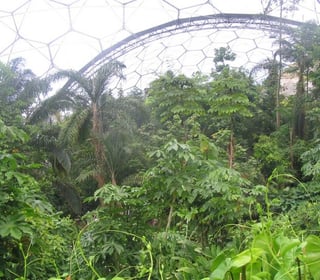How Can We Maintain the Humidity Inside a Greenhouse?
Written by Matt W (Greenhousestores) on 22nd Oct 2018.

A greenhouse can be used for growing all types of plants, even when the weather normally wouldn’t allow them to thrive. For your greenhouse to really work though, humidity is a crucial factor.
A greenhouse’s environment is normally humid, thanks to all the plants packed in close quarters. However, sometimes, humidity must still be introduced or reduced to maintain the proper level your plants need.
The question remains, then:
How can we maintain the proper humidity in a greenhouse?
Greenhouse Basics
Before you try to adjust the humidity in your greenhouse, it’s important to understand the humidity you’re dealing with - the relative humidity. Relative humidity is the percentage of the amount of water vapor present in the atmosphere at a temperature.
When the air warms, it is able to hold more moisture, which is why greenhouses are so warm and humid. Humidity is important in greenhouses because plants love the water in the air.
It can be a problem if it’s unbalanced though, since humidity can affect and encourage pathogens and pests.
Certain nutrients like calcium may not be absorbed by your plants well either if the humidity is too high, while plants cannot grow well if the humidity is too low. This is why you need to keep an eye on the proper humidity levels.
Automated Humidity
Keep in mind that if you’re having trouble maintaining the humidity in your greenhouse, it is possible to use an automated system that will monitor and adjust the humidity at intervals. This is usually only used for commercial greenhouses though.
If you’re unable to use an automated system, there are a few other techniques you are able to use to raise or lower the humidity.
When Humidity Is Too High
If you check your humidity levels and find that it’s too high, there are a few things you are able to do to lower the temperature. First off, try to increase the ventilation. Open your doors, run the fans and get a good air flow going.
This works especially well if your greenhouse is set up with the proper layout. After you’ve ventilated, take a look at the temperature. Temperature influences humidity, but it can be difficult to adjust when you live in a colder area.
You’ll have to ventilate in winter too, so keep an eye on the temperature when you’ve got the doors open.
When Humidity Is Too Low
As mentioned, your plants cannot grow well if your greenhouse doesn’t have the proper amount of humidity in the air. They need a stable environment, so you need to check up often on the humidity level.
If it’s too low, first begin by placing large buckets of water in the greenhouse. The water will evaporate when the greenhouse warms, which will increase humidity. Be sure to clean the water reservoir too so that insects don’t end up breeding there.
Grab your mister to keep your plants moist, with a little more effort on your part. This method takes a little bit of time, depending on the size of the greenhouse, although it will work to raise the humidity in the greenhouse itself.
It will also give individual plants fresh water to help them grow more. If you’re looking for a method that’s less effortful, or if you can’t check in on the greenhouse at all times of the day, place your plants on trays filled with water.
The water will evaporate throughout the day and the moisture will rise to the plants. Finally, if you have a smaller greenhouse, you may also use a humidifier or mist vaporizer from your home.
Just like they do in your home, these little machines will add moisture to the air and increase the relative humidity at the same time.
Air Exchange
You generally ventilate when the humidity is too high, but even if the humidity is low or at a good level, it’s still important to have air exchange in your greenhouse. Keep the air moving with fans, but don’t blow air directly on your plants.
Fan ventilation with airflow will reduce any fast changes in temperature while keeping the air moving. If it gets too cool in your greenhouse, try heat mats to keep the soil warm.
Temperature Monitoring
It’s obvious when your humidity is dangerously high or low when you step in, but slight changes aren’t always noticeable. It’s important to buy a good humidity meter to manage your humidity, rather than relying only on your senses.
Try out a digital thermostat with a humidity meter, or even an electromechanical de-humidistat, which is prewired to help you manage your greenhouse with greater ease and less time.
These meters are affordable and easy to find at any store and will help you maintain the optimal level of 50-70% relative humidity. If your humidity is at 60-80% humidity though, that’s still tolerable.
It really depends on the optimal level for the size of your greenhouse and how many plants you’ve got.
Conclusion
Running a greenhouse isn’t always easy, not when you have to constantly keep an eye on the humidity level to be sure that your plants are growing properly. Whether humidity is too high or too low, your plants can suffer if it’s not at the right level.
If you’re wondering how you can maintain the humidity in your greenhouse, try a few of these methods to keep everything running smoothly. Even something as simple as a humidity meter can make a huge difference.